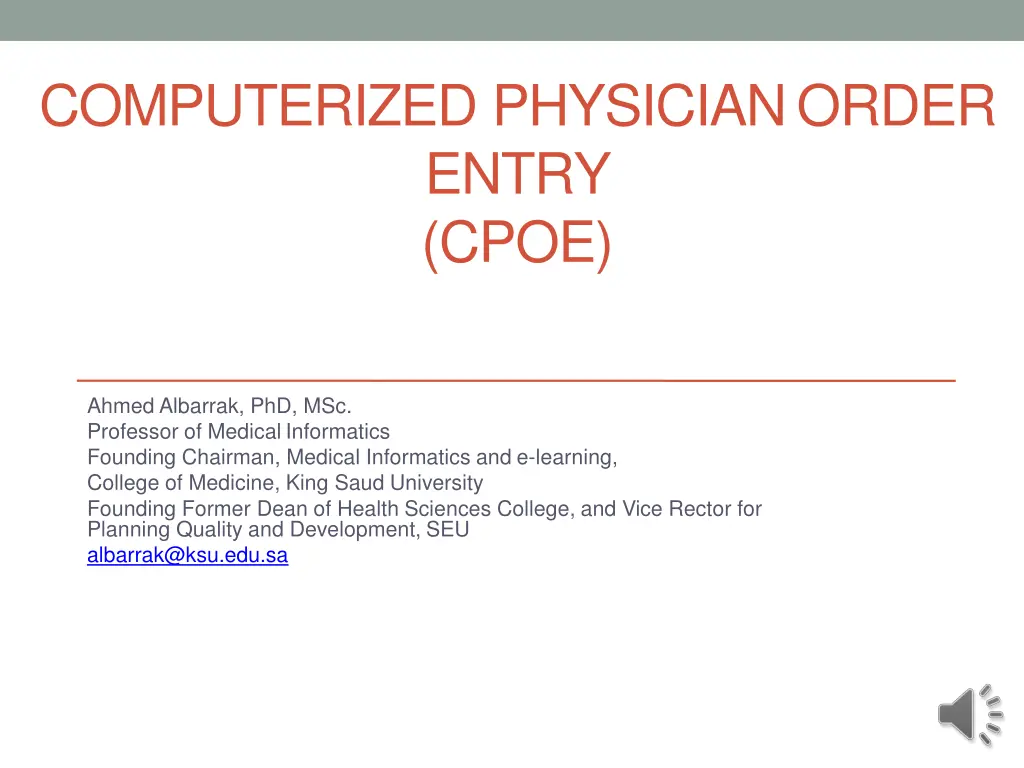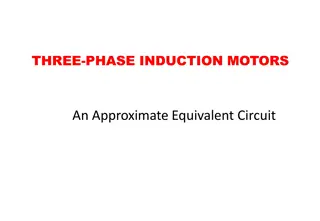
Computerized Physician Order Entry (CPOE): Advantages, Disadvantages, and Implementation
"Learn about Computerized Physician Order Entry (CPOE) from Professor Ahmed Albarrak, including its definition, benefits, drawbacks, and outcomes. Explore how CPOE reduces errors, enhances decision support, and streamlines healthcare processes. Discover why CPOE is a crucial system for patient care efficiency and safety."
Download Presentation

Please find below an Image/Link to download the presentation.
The content on the website is provided AS IS for your information and personal use only. It may not be sold, licensed, or shared on other websites without obtaining consent from the author. If you encounter any issues during the download, it is possible that the publisher has removed the file from their server.
You are allowed to download the files provided on this website for personal or commercial use, subject to the condition that they are used lawfully. All files are the property of their respective owners.
The content on the website is provided AS IS for your information and personal use only. It may not be sold, licensed, or shared on other websites without obtaining consent from the author.
E N D
Presentation Transcript
COMPUTERIZED PHYSICIAN ORDER ENTRY (CPOE) Ahmed Albarrak, PhD, MSc. Professor of MedicalInformatics Founding Chairman, Medical Informatics and e-learning, College of Medicine, King Saud University Founding Former Dean of Health Sciences College, and Vice Rector for Planning Quality and Development, SEU albarrak@ksu.edu.sa
Outline Definition and context Why CPOE? Advantages of CPOE Disadvantages of CPOE Outcome measures and examples Same system other outcome
What CPOEDoes? Provides Decision Support Warns of Drug Interactions Drug-Drug Drug-Allergy Drug-Food Checks Dosing Reduces Transcription Error Reduces number of lost orders Reduces duplicative diagnostic testing Recommends cost effective, therapeutic alternatives
Computerized physician order entry (CPOE) is: The process where a medical professional entering ordersor instructions electronically A process of electronic entry of medical practitioner instructionsfor the treatment of patients Computerized Provider Order Entry or ComputerizedProvider Order Management (CPOM) The process of capturing a physician's instructions for apatient's care electronically to improve the efficiency of caredelivery.
WhatisComputerizedPhysicianOrderEntry (CPOE)? Ordering of tests, medications, and treatments for patient care using computers Involves electronic communication of the orders Often use rules-based methods for checking appropriateness of care
Definitions Information system is an arrangement and integration of: Data Processes People Technology which interact to collect, process, store, and provide as output the information needed to support the organization.
CPOE: Computerized physician order entry (CPOE) is a solution to a current human system problem that focuses on achieving improved quality and safety for all patients
TechnicalInfrastructure EHR Drug information database DSS Others
CPOE, EHR andDSS Documentation D S S Medication EHR Test reports (EKG, PFT) Radiology, lab results CPOE
ExampleDSSinCPOE medicationprescription Allergy Age (check drug name and dose) Duplicate drugs on active orders, not one-time Severe drug interactions Drug-drug, drug-food Dose maximum Drugs with opposite actions
What IsIt? CPOE is a computer application that accepts physician orders Meds Laboratory Tests Diagnostic Studies Ancillary Support Nursing Orders Consults
Why Now? November 1999: Report from the Institute of Medicine To Err is Human: Building a Safer Health System 44,000-98,000 patient deaths/year in U.S. hospitals due to medical errors Increased focus on patient safety and on quality of care CPOE is viewed as an important tool to improve patient safety and quality of care delivered
PatientSafety Top 10 Causes of Death 1998 1. Heart Disease 2. Cancer 3. Stroke 4. Lung Disease Institute of Medicine Report on medical errors released 1999 Estimated that between 44,000 and 98,000 hospital deaths/year are due to medical errors Some question the accuracy of the estimates but has raised public awareness and concern 724,269 538,947 158,060 114,381 98,000* 94,828 64,574 41,826 29,264 26,295 Medical Errors Pneumonia Diabetes Motor Vehicle Suicide Kidney Disease * Estimated 5. 6. 7. 8. 9. 10.






















